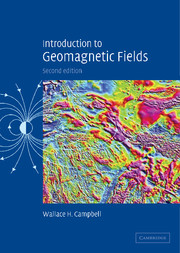Book contents
- Frontmatter
- Contents
- Preface
- Acknowledgements
- 1 The Earth's main field
- 2 Quiet-time field variations and dynamo currents
- 3 Solar–terrestrial activity
- 4 Measurement methods
- 5 Applications
- Appendix A Mathematical topics
- Appendix B Geomagnetic organizations, services, and bibliography
- Appendix C Utility programs for geomagnetic fields
- References
- Index
Appendix B - Geomagnetic organizations, services, and bibliography
Published online by Cambridge University Press: 05 June 2012
- Frontmatter
- Contents
- Preface
- Acknowledgements
- 1 The Earth's main field
- 2 Quiet-time field variations and dynamo currents
- 3 Solar–terrestrial activity
- 4 Measurement methods
- 5 Applications
- Appendix A Mathematical topics
- Appendix B Geomagnetic organizations, services, and bibliography
- Appendix C Utility programs for geomagnetic fields
- References
- Index
Summary
International Unions and Programs
The following quotation was taken, with permission, from The National Geomagnetic Initiative copyright 1993 by the National Academy of Sciences, courtesy of the National Academy Press, Washington, D.C. Revisions of this quoted material have been provided by J.H. Allen in order to modernize the statement to year 2002.
The study of the Earth is intrinsically global. This was recognized by geologists, geodeticists, and geophysicists in the nineteenth century. During the past hundred years, the need for global collaboration in geosciences has become axiomatic; many mechanisms have been developed to encourage international cooperation in Earth sciences. Much international cooperation in science takes place under the non-governmental International Council for Science (ICSU).
By the latter part of the nineteenth century, international expeditions and exchange of datawere common in the geosciences. This led to the development of international mechanisms for ongoing cooperation in geophysical and geological sciences. Seismic and magnetic observatories were being established worldwide. These de facto global networks of magnetic and seismic observatories led to international agreements on measurement standards and data exchange. These international activities led to the formation of an international organization that was the predecessor to the modern International Union of Geodesy and Geophysics (IUGG). The objectives of IUGG are the promotion and coordination of physical, chemical, and mathematical studies of the Earth and geospace environment. IUGG now consists of seven essentially autonomous associations: one of these, the International Association of Geomagnetism and Aeronomy (IAGA), is principally concerned with geomagnetism.
- Type
- Chapter
- Information
- Introduction to Geomagnetic Fields , pp. 296 - 314Publisher: Cambridge University PressPrint publication year: 2003



